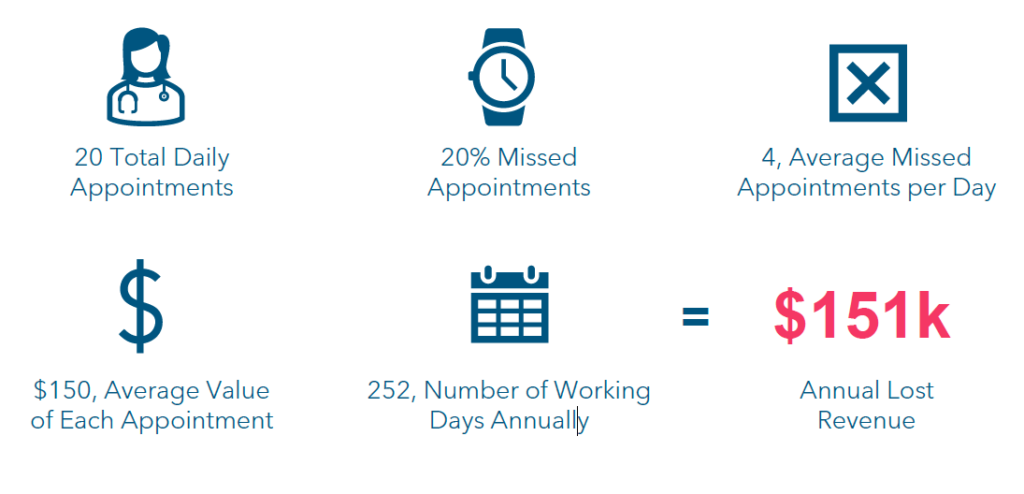
by Ani Osborne
Patient cancellations and no-shows are estimated to cost the healthcare industry over $150 billion dollars every year. According to an MGMA article from September 2021, the combined no-show and late cancellation rates range from 6 – 23%. Clearly this is a huge problem for healthcare clinics and practices – and for patients and payers too.
If patients do not keep their appointments, providers can neither render care nor get reimbursed for their time and services when they sit idle. As many as one out of every five appointment slots go unused, resulting in the average healthcare provider losing up to $150,000 each year or more in missed revenue opportunities. Additionally, many patients who end up rescheduling appointments cancel them down the line anyways causing further revenue losses.
This blog will take a deep dive into the negative financial impact of no-shows and cancellations for healthcare providers and facilities.
Cancellations and no-shows waste valuable time and resources for healthcare providers. Once time is gone, you can never get it back. Through no fault of their own, providers sit idle when patients cancel at the last minute or simply don’t show up for their appointments. And providers are left with an empty slot, unable to bill for time once it’s lost. When healthcare organizations fail to manage, address, and fill these appointment slots, they lose hundreds of thousands of dollars in missed revenue annually.
Some of the most frequent causes of appointment no-shows and late cancellations include:
These factors, either alone or in concert with each other, play a role in predicting patient behavior and whether there will be late cancellations or no-shows. Each patient and the type of appointment needs to be considered uniquely for that patient. And the only way to keep track of more than 50 data points that influence the scheduling propensity for each patient is through machine learning (ML) technology.
No-shows can have both short-term and long-term ramifications when it comes to revenue losses. In addition to lost revenues when patients fail to show up, long-term patient access can also be indirectly affected.
The busiest practices and clinics often book their providers weeks or months in advance due to insufficient staffing for their patient volumes. This leads to patients waiting weeks or months to be seen. During this time, patients can get anxious and seek more timely care at alternative practices. As patient wait times increase, so does their propensity to no-show or cancel. This results in patient attrition between the time of appointment setting and the actual appointment date. And when patients call to re-schedule or cancel their appointments, additional time and resources are needed to process these calls. This unproductive re-scheduling directly adds to expense and directly reduces financial performance.

Hard Dollar Costs of No-shows and Late Cancellations
Failure to reduce the incidence of no-shows, cancellations, and leaving appointment slots empty for follow-up care results in substantial financial impacts for healthcare offices. Consider following financial model for no-shows and late cancellations.

If your practice could reclaim a quarter of lost time (around $37,800) would you jump at the opportunity? You can, by proactively filling empty appointment slots and reducing the total financial burden of missed appointments.
Time is Money
Other industries have difficulty with their customers making and keeping reservations too. Many have deployed technical solutions that also use ML to help them minimize the often-unrecoverable financial losses due to no-shows and late cancels. For example, ML is well used to predict the number of flyers who will not keep their reservation and the number of diners who will be late or who will not show up at a restaurant at all.
In healthcare, machine learning (ML) technology can be trained to predict the likelihood of patient no-shows and cancellations. The WhiteSpace Health Appointment Optimizer ML uses over 50 data points at a time to identify which patients are most likely to have no-shows and cancellations. This valuable information gives your organization an opportunity to react ahead of time, and fill appointments that would otherwise be wasted and revenue that would be foregone.
Aside from the value of missed appointments, there is an enormous cost to re-scheduling appointments. MGMA has published the average time spent scheduling a medical appointment to be around 8 minutes on average. If you multiple eight minutes for each re-scheduled appointment and multiple that product by the total number of re-scheduled appointments annually, you are likely to arrive at 17+ business days of administrative expense per provider. By lowering the number of patient no-shows, late cancels and re-schedules, administrative expenses decrease and provider utilization is improved. Together this lifts revenue.
Minimize No-Shows and Cancellations
WhiteSpace Health is a deep analytics company. Our healthcare revenue cycle analytics uses AI to detect, predict and resolve revenue cycle management and operational issues. The Appointment Optimizer module curates text-based scheduling engagement for each individual appointment that dramatically improves operational – and top line performance.
Appointment Optimizer makes it simple for patients to manage their appointments directly from their mobile phones using simplistic text message replies and commands. As a result, healthcare providers can drastically decrease the likelihood of no-show appointments and lower the administrative expenses due to re-scheduling appointments.
About Ani Osborne

An entrepreneurial product leader, Ani Osborne has spent more than a decade successfully developing and launching products and platforms in the health information technology industry. As head of the B2B products at MDsave, Osborne owned the product vision and strategy that led the company to grow its revenue by 1000% year over year for 7 years, raise $30 million in capital and rank #152 on the 2018 Inc. 5000 List of Fastest-Growing Companies in America. Most recently, she worked closely with Vanderbilt University's Health Affairs team and Whitehouse executives to support the Price Transparency Executive Order Issued by the President in November 2019. Ani Osborne holds multiple patents in the healthcare industry and has earned an MBA from Tennessee Tech University
ani.osborne@whitespacehealth.com.

2424 North Federal Highway, Suite 205
Boca Raton, FL 33431